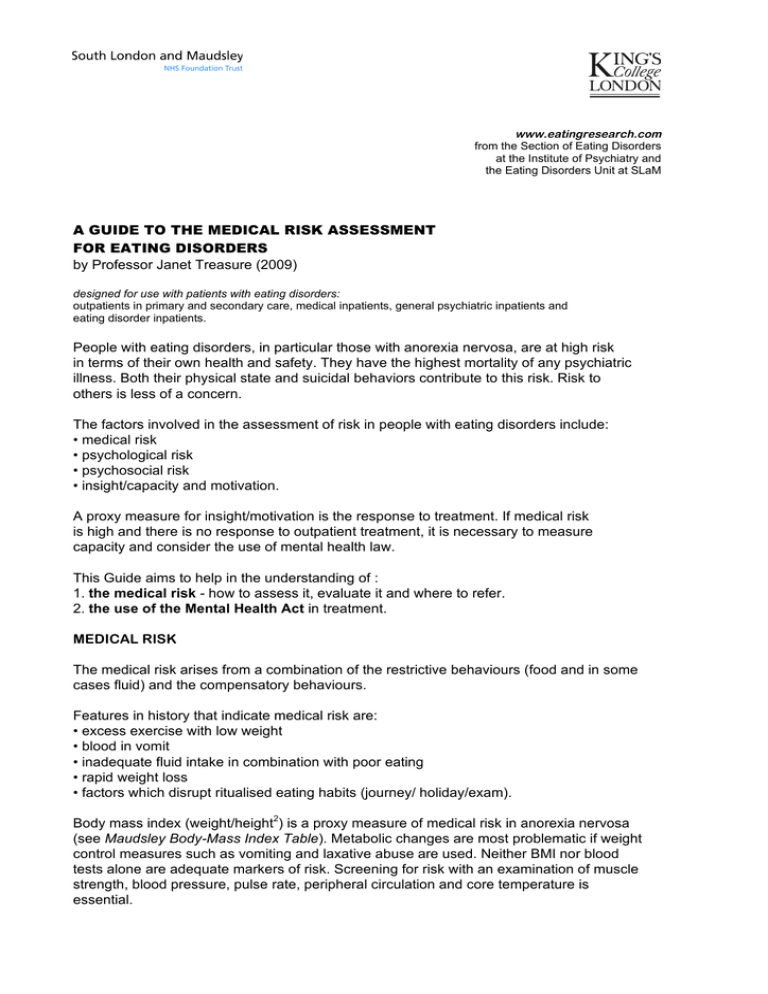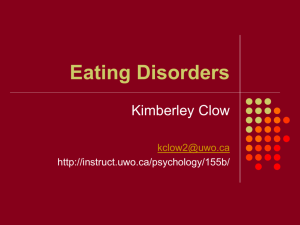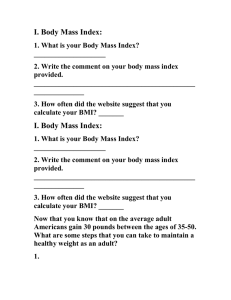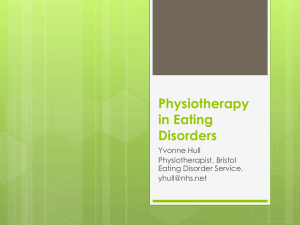A guide to the medical risk assessment for eating disorders
advertisement

www.eatingresearch.com from the Section of Eating Disorders at the Institute of Psychiatry and the Eating Disorders Unit at SLaM A GUIDE TO THE MEDICAL RISK ASSESSMENT FOR EATING DISORDERS by Professor Janet Treasure (2009) designed for use with patients with eating disorders: outpatients in primary and secondary care, medical inpatients, general psychiatric inpatients and eating disorder inpatients. People with eating disorders, in particular those with anorexia nervosa, are at high risk in terms of their own health and safety. They have the highest mortality of any psychiatric illness. Both their physical state and suicidal behaviors contribute to this risk. Risk to others is less of a concern. The factors involved in the assessment of risk in people with eating disorders include: • medical risk • psychological risk • psychosocial risk • insight/capacity and motivation. A proxy measure for insight/motivation is the response to treatment. If medical risk is high and there is no response to outpatient treatment, it is necessary to measure capacity and consider the use of mental health law. This Guide aims to help in the understanding of : 1. the medical risk - how to assess it, evaluate it and where to refer. 2. the use of the Mental Health Act in treatment. MEDICAL RISK The medical risk arises from a combination of the restrictive behaviours (food and in some cases fluid) and the compensatory behaviours. Features in history that indicate medical risk are: • excess exercise with low weight • blood in vomit • inadequate fluid intake in combination with poor eating • rapid weight loss • factors which disrupt ritualised eating habits (journey/ holiday/exam). Body mass index (weight/height2) is a proxy measure of medical risk in anorexia nervosa (see Maudsley Body-Mass Index Table). Metabolic changes are most problematic if weight control measures such as vomiting and laxative abuse are used. Neither BMI nor blood tests alone are adequate markers of risk. Screening for risk with an examination of muscle strength, blood pressure, pulse rate, peripheral circulation and core temperature is essential. Limitations of BMI as a risk marker for anorexia nervosa: • potential for deceit • less reliable if rapid change in weight • less reliable at extremes of height • higher risk for each BMI range for men (taller) • children have a BMI range which changes developmentally* • less reliable if bulimic features • less reliable if fluid restriction • less reliable if physical comorbidity • BMI not critical with regards to risks associated with fluid and electrolyte balance. *In children and adolescents, the cut off for BMI to make the diagnosis is a weight and height below the second centile of BMI. It is possible to get centile charts off the web for the USA (the third centile is depicted) – www.cdc.gov/growthcharts/ Also, Cole and colleagues have produced charts for population norms. Brief essential medical examination We recommend the following for a rapid risk assessment, repeated frequently as necessary: • BMI • blood pressure and pulse rate, lying and standing • muscle strength • examination of the skin and temperature for those at high risk for dryness • a full physical examination looking for eg infection (note can be with normal temperature) and signs of nutritional deficiency. Tests for Muscle Strength (see table below for scoring) 1. The stand up/squat test: The patient is asked to squat down on her haunches and is asked to stand up without using her arms as levers if at all possible. 2. The sit up test: The patient lies flat on a firm surface such as the floor and has to sit up without, if possible, using her hands. Tests for Hydration The sign to notice is dizziness or faintness standing up from sitting. Postural drop, ie the difference between lying and standing blood pressure and heart rate. Investigations 1. Frequent investigations of full blood count and chemistry (FBC, ESR, UE, Cr, CK, Gluc, LFTs) are necessary if: • patients are in a high risk category from a previous assessment • they have a BMI <15 or • the BMI is less reliable due to features outlined above, or • there is a history of purging. 2. ECG is recommended if BMI < 15kg/m2 and if drugs which have an effect on QT interval are prescribed. 3. Any other appropriate physical investigation pertinent to physical state. The table on the next page gives values of concern for each part of the assessment and is followed by a management protocol based on risk. SYSTEM Nutrition Circulation Test or Investigation Concern Alert BMI............................................<14..........<12 Weight loss/week.......................>0.5kg.....>1.0kg Skin Breakdown.........................<0.1cm....>0.2cm Purpuric rash...............................................++ Systolic BP.................................<90...........<80 Diastolic BP................................<70...........<60 Postural drop (sit–stand)............>10............>20 Pulse Rate..................................<50...........<40 Musculo-skeletal (squat and sit-up tests) Temperature Bone Marrow Salt/water Balance Liver Nutrition Differential Diagnosis ECG Unable to get up without using arms for balance..........................++ Unable to get up without using arms as leverage ........................................ ++ Unable to sit up without using arms as leverage.........................++ Unable to sit up at all....................................++ <35C <34.5C <98.0F <97.0F WCC.........................................<4.0.........<2.0 Neutrophil count........................<1.5.........<1.0 Hb..............................................<11.........<9.0 Acute Hb drop.............................................++ (MCV and MCH raised - no acute risk) Platelets....................................<130........<110 K+..............................................<3.5.........<3.0 2. Na+........................................<135........<130 3. Mg++.....................................0.5-0.7......<0.5 4. PO4--.....................................0.5-0.8......<0.5 5. Urea........................................>7............>10 Bilirubin........................................>20.........>40 Alkpase.......................................>110........>200 AsT..............................................>40..........>80 ALT..............................................>45..........>90 GGT.............................................>45......... >90 Albumin........................................<35..........<32 Creatinine Kinase.........................>170........>250 Glucose........................................<3.5........<2.5 TFT, ESR Pulse rate......................................<50...........<40 Corrected QT interval (QTC)........................>450msec Arrythmias.......................................................++ • The baselines for these tests vary between labs. Any abnormal result is an indication for concern and monitoring. • A tachycardia in the presence of signs and investigations of severe risk may be a harbinger of imminent cardiovascular collapse. 1. Scores that do not fall into the risk areas Stable. Regular review and monitoring of above parameters with routine referral to eating disorders unit/secondary services depending on local resources. Unstable. If weight is falling ask the person with anorexia nervosa to come up with plan to ensure that nutritional state does not fall into the risk areas. Regularly review the implementation of this plan. 2. Score/s in the concern area Regular review of parameters (c.weekly) and assessment of capacity with urgent referral to specialised eating disorders team and appropriate medical intervention if needed. As this signifies medical risk this should also be shared with the carer. 3. Score/s in the alert area Immediate contact and referral to eating disorders unit and physicians if outpatient with assessment of capacity. The patient will need urgent specialist and medical assessment. If inpatient – immediate contact with on-call physicians. Useful tips Potassium This is often chronically low in purging, even down to values <1.5 mmol/L, with no immediate sequelae. Acute changes are more dangerous. Regular feeding with control of purging is usually sufficient for re-establishment of normal levels. If potassium replacement is required, because it is usually caused by a loss of gastric secretion, it should be done with oral replacement with a salt and water replacement such as diorylate with regular electrolyte review and examination of fluid and water status (measurement of urea and lying and standing blood pressure). Refractory hypokalaemia can also be due to concurrent low magnesium or calcium, and thus these levels may need checking and rectifying. Serum potassium levels may remain low even with potassium supplements if vomiting persists. A proton pump inhibitor such as lanzoprazole to inhibit gastric acid secretion may reduce metabolic alkalosis and help to conserve potassium but should be a second line measure. Phosphate Rebound hypophosphataemia can occur on initial refeeding as it is sequestered by carbohydrate metabolism. It can be lethal. Initial refeeding including foods with high phosphorus content – eg milk-based products (>2 pints/day) may be helpful. If necessary about 4 days of oral phosphate supplementation may also be needed.** ** In anorexia nervosa it is rare for there to a an isolated deficiency of any mineral or vitamin and therefore multivitamin and mineral replacement is to be recommended eg Forceval 2 capsules day or Sanatogen Gold Refeeding oedema Peripheral oedema is common and harmless during initial refeeding. It resolves within a few weeks spontaneously and rarely needs treatment. It must however be distinguished from oedema secondary to heart failure. Dehydration This can rapidly lead to medical crisis through circulatory and renal failure. All patients should be fully assessed for dehydration. Take a corroborative history of fluid intake and signs of decompensation (dizziness/fainting). The physical examination should include assessment of skin turgicity, ocular pressure and lying and standing blood pressure. Regular electrolyte levels should be checked for high urea, creatinine, sodium and potassium levels. Oral replacement is preferable. Bradycardia Investigation: ECG, look for heart block or prolonged QT. Measure U & E. If <40 admit. Rewarm (if hypothermic) and give a can of Ensure. Monitor HR overnight. THE USE OF THE MENTAL HEALTH ACT (MHA) IN TREATMENT OF ANOREXIA NERVOSA Mental Health Act, Mental Capacity Act and Medical Intervention: If a patient is at medical risk but does not consent to treatment they must be: 1. assessed for capacity 2. treated under the appropriate legal criteria. Capacity is related to a patient’s ability to: • understand information relevant to the specific decision; • be able to understand the nature of their illness and understand the implications of non-treatment • be able to rationally weigh up the pros and cons of treatment; • thus make an informed decision regarding their management and communicate their decision. Under the New MCA (2005) people lacking capacity may be treated if it is in their best interest, if it is the least restrictive option, if it is not depriving them of their liberty and there is no advanced refusal or objection by a donee or court of protection. Treatment of people with severe anorexia nervosa who are not consenting to treatment for their mental disorder will in most cases require use of the MHA as it involves deprivation of liberty and compulsory refeeding. (See MCA 2005 and Deprivation of Liberty Safeguards). Treatment under the Mental Health Act can be given under Section 2 or 3, if they meet the legal criteria (see Code of Practice) whether or not they lack capacity. If after three months from the start of their detention they either lack capacity or object to treatment, SOAD authorisation is required. For people lacking capacity, emergency medical treatment can be performed under Common Law. Non-emergency treatment for a physical condition not related to the eating disorder may be performed under the MCA 2005. The laws regarding treatment for 16 -18 year olds have changed and for somebody refusing treatment, parental consent cannot be used as authority to treat (see Mental Health Act Code of Practice 2007). References Body mass index cut offs to define thinness in children and adolescents: international survey. Tim J Cole, Katherine M Flegal, Dasha Nicholls and Alan A Jackson BMJ 2007; 335 (7612): 194




